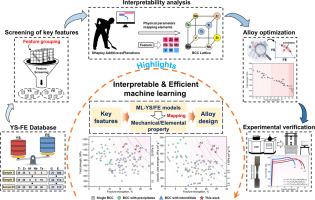利用优化的强化-增韧模型,通过机器学习实现轻量化多主元素合金的可解释和高效设计
IF 14.3
1区 材料科学
Q1 MATERIALS SCIENCE, MULTIDISCIPLINARY
引用次数: 0
摘要
体心立方多主元素合金(BCC mpea)面临着固有的强度-延性权衡。鉴于其巨大的组成空间,确定控制强度和延展性的关键因素,以及开发新的增强-增韧模型以加速以性能为导向的设计,仍然是一个突出的挑战。在这里,我们为BCC mpea开发了一个可解释的机器学习(ML)框架,以确定控制屈服强度(YS)和断裂伸长率(FE)的关键因素。结果表明,FE主要由电负性差Δχpauling、价电子浓度VEC和密度ρ等多因素协同作用产生,而平均剪切模量失配δGave是控制YS的主要因素。使用这些筛选的特征作为输入,我们提出了优化的YS和FE模型,这些模型具有较高的预测精度(YS: R2=0.96, FE: R2=0.84),并且优于现有模型。通过特征-力学性能/元素属性映射将这些ML见解转化为强化/增韧理论,我们设计了三种新型ti - zr基BCC mpea,它们具有优异的性能:YS为1.01 - 1.16 GPa, FE为16.6%-24.5%,比屈服强度为~ 170 MPa cm3 g-1,超过了大多数报道的BCC mpea。这项工作不仅提供了一个数据驱动的策略来克服BCC mpea的强度-延性权衡,而且还建立了可解释的设计原则,以加速发现先进的结构材料。本文章由计算机程序翻译,如有差异,请以英文原文为准。

Achieving interpretable and efficient design of lightweight multi-principal element alloys via machine learning with optimized strengthening-toughening models
Body-centered cubic multi-principal element alloys (BCC MPEAs) face inherent strength-ductility trade-offs. Given their vast compositional space, identifying key factors governing strength and ductility, as well as developing novel strengthening-toughening models to accelerate the property-oriented design, remains an outstanding challenge. Here, we developed an interpretable machine learning (ML) framework for BCC MPEAs to identify the key factors governing yield strength (YS) and fracture elongation (FE). The results demonstrate that FE mainly arises from the synergistic effects of multiple factors (electronegativity difference Δχpauling, valence electron concentration VEC, and density ρ), while average shear modulus mismatch δGave is the dominant factor controlling YS. Using these screened features as inputs, we propose optimized YS and FE models that achieve high predictive accuracy (YS: R2=0.96, FE: R2=0.84) and outperform existing models. By transforming these ML insights into strengthening/toughening theories via feature-to-mechanical performance/element property mapping, we designed three novel Ti-Zr-based BCC MPEAs with exceptional properties: YS of 1.07–1.16 GPa, FE of 16.6%–24.5%, and specific yield strength of ∼170 MPa cm3 g-1, surpassing most reported BCC MPEAs. This work not only provides a data-driven strategy to overcome the strength-ductility trade-off in BCC MPEAs but also establishes interpretable design principles for accelerating the discovery of advanced structural materials.
求助全文
通过发布文献求助,成功后即可免费获取论文全文。
去求助
来源期刊

Journal of Materials Science & Technology
工程技术-材料科学:综合
CiteScore
20.00
自引率
11.00%
发文量
995
审稿时长
13 days
期刊介绍:
Journal of Materials Science & Technology strives to promote global collaboration in the field of materials science and technology. It primarily publishes original research papers, invited review articles, letters, research notes, and summaries of scientific achievements. The journal covers a wide range of materials science and technology topics, including metallic materials, inorganic nonmetallic materials, and composite materials.
 求助内容:
求助内容: 应助结果提醒方式:
应助结果提醒方式:


